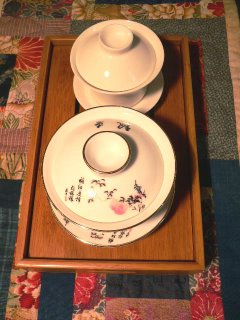 The previous test with light fragrant Bi Luo Chun gave me the idea to test a top quality, heavily roasted Tie Guan Yin with these 2 gaiwans. Let's see how the tickness of the gaiwan's walls impacts tea with stronger fragrance and taste.
The previous test with light fragrant Bi Luo Chun gave me the idea to test a top quality, heavily roasted Tie Guan Yin with these 2 gaiwans. Let's see how the tickness of the gaiwan's walls impacts tea with stronger fragrance and taste. What I found is that the thinner gaiwan gave a more precise and fragrant account of the tea. The smell under its lid was clearer and better than under the lid of the thick gaiwan. This confirmed the previous findings concerning the fragrance.
However, the tea from the thick gaiwan tasted longer and had more body. Its mellow, sweet aftertaste, typical for roasted tea, was much better than in the thin gaiwan. By cooling off faster with its thin walls, the tie guan yin didn't release the heavier componenents that should be part of the tea.
Conclusion: gaiwans with thin walls are not necessarily better. It really depends on the tea you're making. Best is to have a wall thickness that fits the 'body' level of your tea.







1 comment:
I've reached the same conclusion with a huang shan Mao feng and a high altitude Oolong : I tried them both in a thin and a thick Gaiwan.
The Oolong, with it's though, thick leaves, prefered the thick gaiwan, while the green tea was more subtle with the thin walls.
Post a Comment